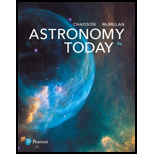
Astronomy Today (9th Edition)
9th Edition
ISBN: 9780134450278
Author: Eric Chaisson, Steve McMillan
Publisher: PEARSON
expand_more
expand_more
format_list_bulleted
Question
Chapter 2, Problem 6P
To determine
The magnitude of acceleration at following altitudes above the Earth, if the acceleration due to gravity at Earth's surface is
(a).
(b).
(c).
Expert Solution & Answer
Want to see the full answer?
Check out a sample textbook solution
Students have asked these similar questions
56 is not the correct answer!
81 SSM Figure 29-84 shows a cross
section of an infinite conducting
sheet carrying a current per unit
x-length of 2; the current emerges
perpendicularly out of the page.
(a) Use the Biot-Savart law and
symmetry to show that for all points
B
•P
x
B
P'.
Figure 29-84 Problem 81.
P above the sheet and all points P' below it, the magnetic field B
is parallel to the sheet and directed as shown. (b) Use Ampere's
law to prove that B = ½µλ at all points P and P'.
(λvacuum =640nm)
red light
(λ vacuum = 640 nm) and green light
perpendicularly
on a soap film (n=1.31)
A mixture of
(a vacuum = 512 nm) shines
that has air on both side. What is the minimum nonzero
thickness of the film, so that destructive interference
to look red in reflected light?
nm
Causes it
Chapter 2 Solutions
Astronomy Today (9th Edition)
Ch. 2 - Prob. 1DCh. 2 - Prob. 2DCh. 2 - Prob. 3DCh. 2 - Prob. 4DCh. 2 - Prob. 5DCh. 2 - Prob. 6DCh. 2 - Prob. 7DCh. 2 - Prob. 8DCh. 2 - Prob. 9DCh. 2 - Prob. 10D
Ch. 2 - Prob. 11DCh. 2 - Prob. 12DCh. 2 - Prob. 13DCh. 2 - Prob. 14DCh. 2 - Prob. 15DCh. 2 - Prob. 1MCCh. 2 - Prob. 2MCCh. 2 - Prob. 3MCCh. 2 - Prob. 4MCCh. 2 - Prob. 5MCCh. 2 - Prob. 6MCCh. 2 - Prob. 7MCCh. 2 - Prob. 8MCCh. 2 - Prob. 9MCCh. 2 - Prob. 10MCCh. 2 - Prob. 1PCh. 2 - Prob. 2PCh. 2 - Prob. 3PCh. 2 - Prob. 4PCh. 2 - Prob. 5PCh. 2 - Prob. 6PCh. 2 - Prob. 7PCh. 2 - Prob. 8P
Knowledge Booster
Learn more about
Need a deep-dive on the concept behind this application? Look no further. Learn more about this topic, physics and related others by exploring similar questions and additional content below.Similar questions
- Suppose the inteference pattern shown in the figure below is produced by monochromatic light passing through a diffraction grating, that has 260 lines/mm, and onto a screen 1.40m away. What is the wavelength of light if the distance between the dashed lines is 180cm? nmarrow_forwardHow many (whole) dark fringes will produced on on an infinitely large screen if red light (2)=700 nm) is incident on two slits that are 20.0 μm apart?arrow_forwardCan someone help me with this physics 2 problem thank you.arrow_forward
arrow_back_ios
SEE MORE QUESTIONS
arrow_forward_ios
Recommended textbooks for you
 AstronomyPhysicsISBN:9781938168284Author:Andrew Fraknoi; David Morrison; Sidney C. WolffPublisher:OpenStax
AstronomyPhysicsISBN:9781938168284Author:Andrew Fraknoi; David Morrison; Sidney C. WolffPublisher:OpenStax
 Physics for Scientists and Engineers: Foundations...PhysicsISBN:9781133939146Author:Katz, Debora M.Publisher:Cengage Learning
Physics for Scientists and Engineers: Foundations...PhysicsISBN:9781133939146Author:Katz, Debora M.Publisher:Cengage Learning Horizons: Exploring the Universe (MindTap Course ...PhysicsISBN:9781305960961Author:Michael A. Seeds, Dana BackmanPublisher:Cengage Learning
Horizons: Exploring the Universe (MindTap Course ...PhysicsISBN:9781305960961Author:Michael A. Seeds, Dana BackmanPublisher:Cengage Learning An Introduction to Physical SciencePhysicsISBN:9781305079137Author:James Shipman, Jerry D. Wilson, Charles A. Higgins, Omar TorresPublisher:Cengage Learning
An Introduction to Physical SciencePhysicsISBN:9781305079137Author:James Shipman, Jerry D. Wilson, Charles A. Higgins, Omar TorresPublisher:Cengage Learning Principles of Physics: A Calculus-Based TextPhysicsISBN:9781133104261Author:Raymond A. Serway, John W. JewettPublisher:Cengage Learning
Principles of Physics: A Calculus-Based TextPhysicsISBN:9781133104261Author:Raymond A. Serway, John W. JewettPublisher:Cengage Learning

Astronomy
Physics
ISBN:9781938168284
Author:Andrew Fraknoi; David Morrison; Sidney C. Wolff
Publisher:OpenStax


Physics for Scientists and Engineers: Foundations...
Physics
ISBN:9781133939146
Author:Katz, Debora M.
Publisher:Cengage Learning

Horizons: Exploring the Universe (MindTap Course ...
Physics
ISBN:9781305960961
Author:Michael A. Seeds, Dana Backman
Publisher:Cengage Learning

An Introduction to Physical Science
Physics
ISBN:9781305079137
Author:James Shipman, Jerry D. Wilson, Charles A. Higgins, Omar Torres
Publisher:Cengage Learning

Principles of Physics: A Calculus-Based Text
Physics
ISBN:9781133104261
Author:Raymond A. Serway, John W. Jewett
Publisher:Cengage Learning
Kepler's Three Laws Explained; Author: PhysicsHigh;https://www.youtube.com/watch?v=kyR6EO_RMKE;License: Standard YouTube License, CC-BY